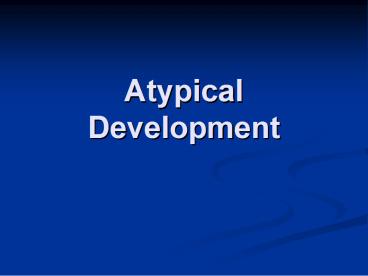Atypical Development - PowerPoint PPT Presentation
1 / 28
Title: Atypical Development
1
Atypical Development
2
Gonadal Intersexuality ("True Hermaphroditism")
3
Gonadal Intersexuality
- Either 2 ovotestes or 1 ovary and 1 testis
- Very rare, appear more feminine masculine.
- Usually, XX with an SRY gene translocated on one
X. Tissue in which that X is expressed is
masculinized. - Sometimes, an XX and XY conceptus fuse or 1 sperm
fertilizes the oocyte and 1 fertilizes the polar
body, which fails to degenerate. - Several have become pregnant and delivered
children one fathered a child.
4
Chromosomal Anomalies
- Turners syndrome
Klinefelters syndrome
XXY genotype SRY male Internal sex OK Small t
estes
Low T Low sperm gynecomastia
X0 genotype Poor ovaries Low hormone Immature s
ex
infertile
5
Metaphase
Nondisjunction
Normal Anaphase
6
Turners syndrome
- X0
- Lack normal ovaries granulosa cells need
oocytes, just as oocytes need granulosa cells.
(gap junctions) - Infertile, no puberty, deficits in visuospatial
skills - Treated with GH testosterone for growth, and
with E P for breast development, menstrual
cycles, and can bear children with donated eggs.
7
Klinefelters syndrome
- XXY, XXXY
- Male SRY trumps any number of DAX-1 genes, as
long as they are on different X chromosomes - Tall, small testes, breast development, sparse
body hair, low T, low sperm count, low libido - Learning disabilities, especially for language
- Can be treated with T
8
Congenital Adrenal Hyperplasia
- Genetic defect
- Corticoid synthesis
- Adrenal cortex
- Deficit corticoids
- Excess T
- XX
- No MIH
- Wolffian Duct
- External genitals
- masculinized
9
Congenital adrenal hyperplasia
- Lack of enzyme ? cortisol (21 hydroxylase)
therefore, decreased feedback ? excess ACTH ?
adrenal cortex hypertrophies (hyperplasia)
produces more of whatever it can, including
androgens - Recessive trait, treated with corticosteroids
- In male differentiation OK, but early puberty
and cessation of growth. - In female enlarged clitoris and fused labia.
- Play more with boys toys, less interested in
motherhood, more inclined to male-typical
activities and careers, more likely to be
attracted to women, but more hetero- than
lesbian, excel in visuospatial tasks
10
5alpha-Reductase Deficiency
- Child at birth
Appearance at puberty
11
5-alpha reductase deficiency
- Normal internal genitalia testes secrete T, MIH
causes Mullerian ducts to degenerate. - Lack of DHT leads to inadequate masculinization
of external genitalia at birth - Testes in labia or inguinal canal
- Urogenital sinus urethra blind vagina
- Prostate gland small or absent
- At puberty, lots of T ? testes descend, scrotum
darkens, phallus enlarges, muscular, deep voice
12
Androgen Insensitivity Syndrome
- Nongonadal
- XY
- Mutation T-receptor
- Insensitive to T
- Normal testes
- MIH T
- Woffian fail
- External fail
- Complete/partial
13
Androgen Insensitivity Syndrome
- XY, normal testes, secrete T
- Due to mutation in gene for androgen receptor
- Sometimes only partial insensitivity to
androgens - Convert T ? E ? breast development
- Do not menstruate or have pubic or underarm hair
14
Neural differentiation
15
Third interstitial nucleus of the anterior
hypothalamus (INAH3)
16
(No Transcript)
17
INAH3
- Larger in heterosexual men than in women or gay
men, though considerable overlap - Same was true in men who did not die of AIDS
therefore, not due to AIDS - Function not clear
18
(No Transcript)
19
Sexual differentiation in hypothalamus
20
SDN-POA of rats
- Same size in male and female fetuses before day
18 of gestation - T surges in males (day 18 of gestation and again
birth) ? larger SDN in males females - Neurons die in females due to lack of T during
early development cant be rescued by T
injections after 1 week postnatal. - T ? E directly in MPOA is necessary.
- Castration in adulthood ? no effect
21
(No Transcript)
22
Development of sexual dimorphism of rat spinal
nucleus of the bulbocavernosus
23
SNB in rats
- Spinal nucleus of bulbocavernosus
- Male and female fetuses have similar SNBs and
similar bulbocavernosus muscles. - Muscles, but not neurons, have androgen receptors
and depend on androgen. - Females lack the T surge, so muscles atrophy
- Male muscles send trophic factors to neurons,
which survive. Therefore, indirect effect of T.
24
Hormones and sexual behavior in rats
25
Aromatization hypothesis
- In rats and other rodents E is as effective as T
in masculinizing and defeminizing behavior. - Blocking aromatization is often (but not always)
as effective as blocking T production. - Why arent females masculinized by their mothers
(or their own) E? - Alpha-fetoprotein binds E, but not T keeps much
of it in blood and out of cells - a-FP can be swamped by excess E or T injections
- Therefore, T is a sneaky way to get E to brain.
26
(No Transcript)
27
Peripheral development
- Development of external genitals and spinal
nuclei are androgen dependent, though. - Spotted hyenas
- Females are dominant, aggressive, secrete high
levels of androstenedione. - Female-typical SDN-POA, and do mate and give
birthbut with difficulty!!
28
(No Transcript)































